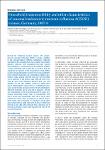Household transmissibility and other characteristics of seasonal oseltamivir-resistant influenza A(H1N1) viruses, Germany, 2007-8
Buchholz, Udo
Brockmann, Stefan
Duwe, Susanne
Schweiger, Brunhilde
Heiden, Matthias an der
Reinhardt, Bernd
Buda, Silke
During the influenza season 2007-8, the proportion of seasonal influenza A(H1N1) viruses resistant to the neuraminidase inhibitor oseltamivir increased worldwide. We conducted an investigation to compare patients infected with oseltamivir-resistant (ose-R) and oseltamivir- susceptible (ose-S) influenza A(H1N1) viruses regarding risk factors for resistance and the capability to transmit in the household setting. Within a cohort of 396 laboratory confirmed influenza patients from sentinel physicians we conducted a nested casecontrol study among patients infected with A(H1N1). Thirty patients in the cohort were infected with influenza B, none with influenza A(H3N2) and 366 with A(H1N1). Of the 366 A(H1N1) viruses 52 (14%) were ose-R. Demographic characteristics, oseltamivir exposure, travel history and outcome were not significantly different between ose-S and ose-R patients. Among 133 households in the nested case-control study, secondary household attack rates in households with ose-R cases and households with ose-S cases were similar (23 versus 26%; p-value=0.54). Ose-R household status and occurrence of secondary cases were associated with an odds ratio of 0.85 (95% confidence interval 0.38-1.88). We conclude that seasonal ose-R influenza A(H1N1) viruses have transmitted well in the household setting.
Dateien zu dieser Publikation
Keine Lizenzangabe

